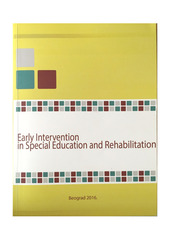Приказ основних података о документу
Lip reading with deaf and hard of hearing preschool children
| dc.contributor | Nikolić Snežana | |
| dc.contributor | Nikić Radmila | |
| dc.contributor | Ilanković Vera | |
| dc.creator | Isaković, Ljubica | |
| dc.creator | Kovačević, Tamara | |
| dc.creator | Dimić, Nadežda | |
| dc.date.accessioned | 2021-06-17T13:25:29Z | |
| dc.date.available | 2021-06-17T13:25:29Z | |
| dc.date.issued | 2016 | |
| dc.identifier.isbn | 978-86-6203-086-3 | |
| dc.identifier.isbn | 978-86-6203-086-3 | |
| dc.identifier.uri | http://rfasper.fasper.bg.ac.rs/handle/123456789/2555 | |
| dc.description.abstract | Pedagogical and educational work with deaf and hard of hearing children is characterized by the application and teaching of lip-reading. Speech is acquired spontaneously by listening. In the absence of auditory stimuli, deaf and hard of hearing children follow carefully the movements of the lips of a person who speaks. Thus, visible images of the movements of speech organs which take part in the articulation are created. Visual perception of speech does not only involve recognition of each individual sound, but it is also important that a child should perceive the information as a whole and understand its meaning. The aim of our research was to establish the level of success in lip-reading separate terms and sentences with deaf and hard of hearing preschool children. We examined the success in lip-reading within the following areas: body parts, domestic and wild animals and clothes and shoes. Moreover, we examined the acquisition of first adjectives, verbs and pronouns which children at this age should have learnt as well as the success in lip-reading sentences (which related to the story “the Gigantic Turnip“), which we checked though pictures. The sample comprised 15 preschool children who attend preschool groups at schools in Belgrade. The results obtained show that the terms within the area of body parts are best lipread, while the poorest results were achieved in lip-reading terms relating to clothes and shoes. The terms which are more frequent, which are used more and which the children have had some experience with are better lip-read although they are less legible by the structure of sounds. The significance of early knowledge of signs facilitates the acquisition of terms as well as lip-reading. A lot of children responded to the spoken term with an adequate sign and showed a higher level of understanding of what was spoken than the children who did not use a sign (a gesture). In lip-reading sentences, the children perceived the length of sentences and recognized individual terms, while they gave adequate responses from the context of pictures. | |
| dc.language | en | |
| dc.publisher | University of Belgrade, Faculty of Special Education and Rehabilitation, Serbia / Univerzitet u Beogradu – Fakultet za specijalnu edukaciju i rehabilitaciju | |
| dc.rights | openAccess | |
| dc.rights.uri | https://creativecommons.org/licenses/by-sa/4.0/ | |
| dc.source | Thematic Collection of International Importance- Early Intervention in Special Education and Rehabilitation“, Beograd, Srbija, 2016. | |
| dc.subject | lip-reading | |
| dc.subject | visibility (legibility) of sounds | |
| dc.subject | deaf and hard of hearing children | |
| dc.subject | preschool age | |
| dc.title | Lip reading with deaf and hard of hearing preschool children | en |
| dc.type | conferenceObject | |
| dc.rights.license | BY-SA | |
| dc.citation.epage | 207 | |
| dc.citation.other | : 195-207 | |
| dc.citation.rank | M14 | |
| dc.citation.spage | 195 | |
| dc.identifier.fulltext | http://rfasper.fasper.bg.ac.rs/bitstream/id/6276/Untitled14.pdf | |
| dc.identifier.rcub | https://hdl.handle.net/21.15107/rcub_rfasper_2555 | |
| dc.type.version | publishedVersion |


